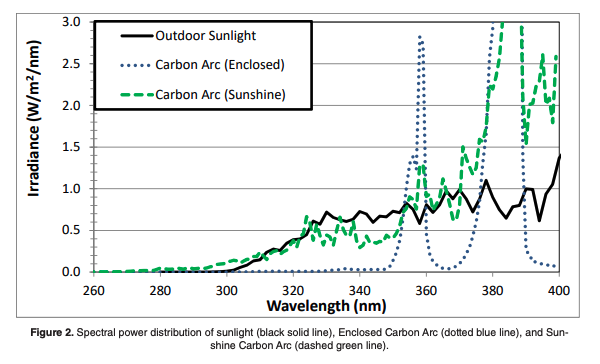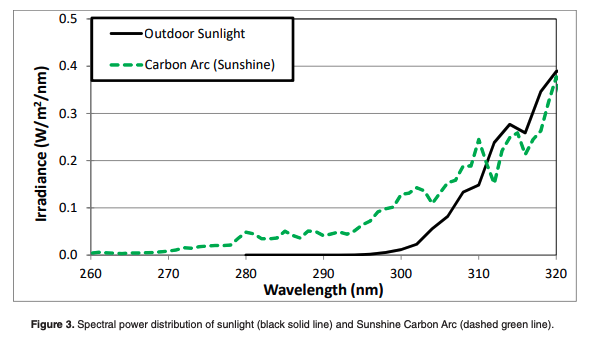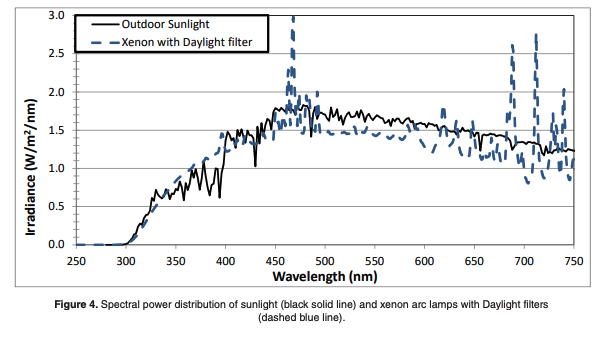LX-5104 A Comparison between Carbon Arc and Xenon Arc Accelerated Weathering Testing
Technical Bulletins
Posted 2023
Last Updated 2023
LX-5104
Weathering is an important cause of damage to plastics, textiles, coatings, and other organic materials. Accelerated weathering testers are used to simulate this damage for research and development, quality control, certification, and correlation to performance in service environments. The most common instruments used today to conduct accelerated weathering testing are xenon arc testers and fluorescent UV testers.
Carbon Arc accelerated weathering testing has been used for over a century for accelerated weathering and lightfastness testing. Enclosed Carbon Arc technology was first introduced in 1918 and Sunshine Carbon Arc in 1933. Most modern test standards have moved away from carbon arc light sources in favor of xenon arc and fluorescent UV testing because carbon arc instruments are expensive, difficult to operate, and do not reproduce well actual weathering and photodegradation. However, despite their decline in popularity, carbon arc light sources are still specified in some historical Japanese standards. Carbon arc test apparatuses share some characteristics with xenon arc testers, but there are significant differences between them that generally favor the xenon arc approach. This Technical Bulletin outlines the differences between xenon arc and carbon arc testers in several important areas: light spectrum, water simulation, and required maintenance and cost.
Light Spectra
Photochemical degradation is caused by photons of light breaking chemical bonds. For each type of chemical bond there is a critical energy that is required to cause a reaction. That energy corresponds to a particular wavelength of light. Photons of any wavelength shorter (higher energy) than that threshold value can break the bond, but longer wavelengths of light cannot break it regardless of their intensity (brightness). As a result, short-wavelength ultraviolet (UV) light is responsible for most polymer degradation. The shortest wavelength of outdoor sunlight is 295 nm, so if a particular material is only sensitive to UV light of wavelengths below 295 nm, it will never experience photochemical deterioration outdoors. If the same polymer is exposed to a laboratory light source that has a spectral cut-off of 280 nm, it will deteriorate. Although light sources that produce shorter wavelengths produce faster tests, there is a possibility of anomalous results if a tester has a wavelength cut-off below that of the material's end use environment. The short-wavelength region of carbon arc light spectra are important to consider with reference to natural sunlight.
Carbon Arc Spectra
Carbon arc light sources are used in accelerated weathering testing in order to simulate the effects of sunlight. Figure 2 shows a spectral power distribution (SPD) that illustrates the emitted light spectra of both Enclosed Carbon Arc and Sunshine Carbon Arc, as compared to natural sunlight outdoors. The Sunshine Carbon Arc and the Enclosed Carbon Arc light sources clearly both have serious differences with respect to a natural solar spectrum.
The UV output of the Enclosed Carbon Arc primarily consists of two very large spikes of energy, much more intense than natural sunlight, centered around 360 nm and 380 nm. This spectrum has very little output below 350 nm. The Enclosed Carbon Arc is therefore likely to be a very weak and inadequate test for photostability, since UV light with wavelengths shorter than 320 nm is responsible for nearly all polymer degradation.

The Sunshine Carbon Arc has a large spike of energy, much greater than sunlight, at about 385 nm. The more serious problem with the spectrum of the Sunshine Carbon Arc is found in the short wavelengths, and is the opposite of the problem described previously for Enclosed Carbon Arc. To illustrate this, Figure 3 shows sunlight compared to Sunshine Carbon Arc, focused between 260-320 nm. The carbon arc source emits a great deal of energy below the normal solar cut-off of 295 nm. Radiation of this type is realistic for outer space, but not at the earth's surface. These short wavelengths can cause unrealistic degradation when compared to natural exposures. Figure 2. Spectral power distribution of sunlight (black solid line), Enclosed Carbon Arc (dotted blue line), and Sunshine Carbon Arc (dashed green line). The Sunshine Carbon Arc has a large spike of energy, much greater than sunlight, at about 385 nm. The more serious problem with the spectrum of the Sunshine Carbon Arc is found in the short wavelengths, and is the opposite of the problem described previously for Enclosed Carbon Arc. To illustrate this, Figure 3 shows sunlight compared to Sunshine Carbon Arc, focused between 260-320 nm. The carbon arc source emits a great deal of energy below the normal solar cut-off of 295 nm. Radiation of this type is realistic for outer space, but not at the earth's surface. These short wavelengths can cause unrealistic degradation when compared to natural exposures.

Xenon Lamp Spectra
Xenon arc lamps offer the best simulation of full-spectrum sunlight available in an accelerated weathering test. In addition to a superior match in the UV region, the color temp of xenon (~6000 K) matches natural outdoor sunlight much better than enclosed carbon arc, which peaks in the near-IR. The light spectrum that is delivered to test specimens in a xenon arc tester can be modified by the use of optical filters, for different exposure applications. For further information see Q-Lab Bulletin LX-5060 - A Choice of Filters for Q-SUN.
The most common type of optical filters for xenon arc is called Daylight. As the name implies, Daylight filters are meant to simulate natural outdoor sunlight. Figure 4 shows the excellent match between the full solar spectrum and a xenon arc spectrum with Daylight optical filters. A xenon lamp with proper optical filter reproduces well the UV portion of sunlight as well as the visible light portion.

Window filters are also used commonly in xenon arc accelerated weathering testing. These filters simulate sunlight passing through window glass to materials indoors. A variety of Window glass filters are available to simulate glass with various characteristics. For even faster test results than Daylight xenon arc tests, some standards may call for an Extended-UV optical filter, which transmits more shortwave UV light than a Daylight filter. Although this may produce faster test results, the presence of photons with shorter wavelengths than materials experience on Earth may result in unnatural modes of material degradation. This is similar to the concern with using Sunshine Carbon Arc instruments.
Water Simulation
Carbon and xenon arc testers are very similar in their physical construction. Both testers use a system of intermittent water spray as the primary method for simulating the effects of rain and dew. Xenon are testers may also use controlled relative humidity to influence specimen time of wetness. Both are fundamentally different from the water delivery in a fluorescent UV accelerated tester, where hot condensation provides a realistic simulation of outdoor moisture attack.
Test standards that call for the use of carbon arcs are typically very old and have not been updated in decades. When they do call for water spray, these standards usually specify a “102/18” test cycle, alternating between 102 minutes of light and 18 minutes of light plus water spray. This cycle was developed based on hardware limitations of early carbon arc test instruments, and not with any scientific basis or for correlation with natural outdoor water cycles. The provision of water while specimens are exposed to light can cause unnatural thermal shock of materials, as most outdoor water is actually delivered during dark or cloudy periods. Additionally, 18 minutes is too short of a time period to saturate many durable materials and produce realistic water-based degradation. This is especially true because water spray steps are in 102/18 cycles take place when the light is still on, which dries specimens quickly. Standards have been developed - but only for xenon arc testers – that endeavor to provide longer water spray periods under dark conditions to better correlate to outdoor environments. These standards include ASTM D7869 and the widely-used SAE J2527. As a result, carbon arc test standards are likely to be water-deficient and will not correlate as well with outdoor results.
Maintenance and Operating Considerations
Carbon arc test instruments require daily cleaning and carbon rod replacement. Carbon arc testers utilize carbon rods that are "burned" to produce light. The carbons last for about 23 hours and have to be replaced daily. This procedure typically takes over an hour every day. Filters must also be cleaned and replaced frequently. In contrast, xenon arc lamps only need to be replaced every 1500 light-hours. Optical filters should be cleaned periodically, but in air-cooled test instruments like Q-SUN testers, they generally do not ever need to be replaced.
The irradiance output of carbon arc lamps during testing is determined by a fixed input power to the carbon rods. As a result it is not controlled like in a SOLAR EYE system and is subject to change. Xenon arc accelerated weathering testers, on the other hand, use electronic irradiance control systems. These consist of a programmable controller that continuously monitors the irradiance intensity and, via a feedback loop system, maintains the programmed irradiance level by adjusting power to xenon lamps.
Furthermore, the total output and emission spectra may vary from one rod to another. This can create variability in results from short-term tests. It may or may not cause problems for exposures that last several weeks, where the differences in output may be averaged out. A more important cause for variability in results from carbon arc testers is filter aging. Upon exposure to short wavelength UV light, carbon arc filters lose some of their ability to transmit light. A haze that is obvious to the naked eye builds up on the filter over time. In addition, carbon smut from the combustion process is deposited on the filters and must be removed daily. Imperfect cleaning further contributes to a lack of uniform irradiance in carbon arc testers. Consequently, carbon arcs with new, unsolarized filters have a different SPD than testers with older filters. The drop in visible light output is about 20%. The change in intensity in the more damaging UV approaches 70 %. Changes of this magnitude will make significant differences in test results.
Summary
Carbon arc light sources have been used to conduct accelerated weathering testing for over a century. Their use has waned over the past few decades as superior light sources like xenon arc and fluorescent UV have replaced them. Xenon arc lamps offer a far better spectral match to natural sunlight than carbon arc light sources and deliver precise irradiance output using irradiance control systems. Xenon arc lamps thus offer more realistic and consistent testing than carbon arc lamps. From an operational standpoint, carbon arc lamps are dirty when handling, require frequent maintenance, and experience large changes in spectral output. As a result, xenon arc accelerated weathering tests enjoy wide use in modern testing while carbon arc instruments are almost entirely a thing of the past.